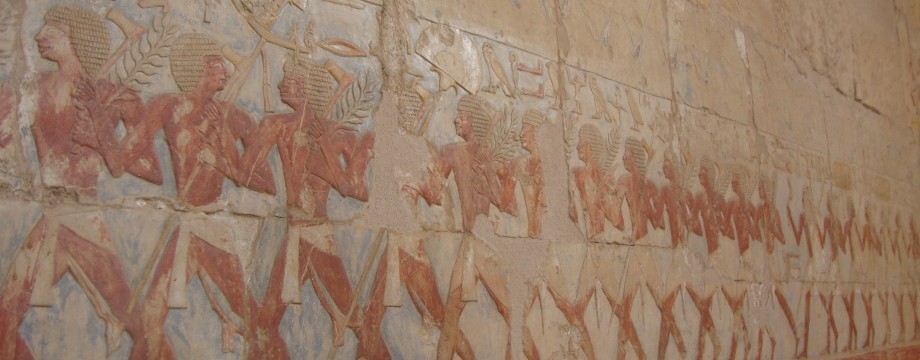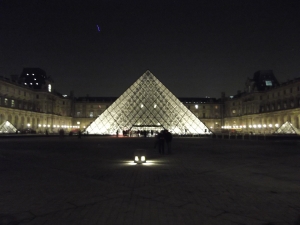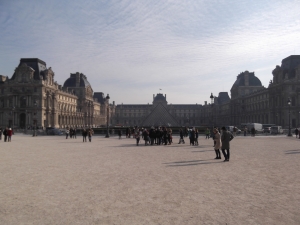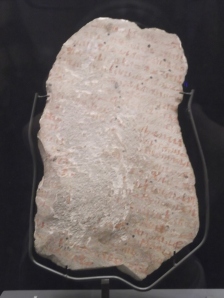This is the first of many Texts from Ancient Egypt that I will post on here in translation. They will probably gravitate towards the research I am performing on personal religion. This text comes from an inscribed stela from Deir el-Medina, and details Neferabu’s experience of the divine punishment of Ptah. This stela, BM EA 589, forms part of the “personal piety” corpus of the New Kingdom and dates from around the time of Ramesses II. It is also unusual for the fact that it is inscribed with text on both sides.
It is housed in the British Museum and is only small at 39 cm x 8cm x 5cm. It was probably placed in the Ptah sanctuary on the path from Deir el-Medina (the village of the workmen working in the valley) to the Valley of the Kings (the place of truth that is mentioned in the text). The “recto”/front of the stela shows the owner Neferabu (in the bottom right) adoring Ptah, who is sat in front of a table of offerings.The upper register also shows a number of carved ears, so that Ptah may hear the call of Neferabu. The lower register of the front is a short hymn to Ptah. However, the part of this artefact that I am focussing on in this post is the text inscribed on the “verso”/back of the stela (shown at the bottom of this post). So here’s what it says:
BM EA 589 “verso”
The beginning of the recital of the power of Ptah, of his south wall, by the servant in the place of truth in the west of Thebes, Neferabu, the justified.
He says:
“I am a man who swore falsely by Ptah, Lord of Truth- he caused me say darkness by day.
I will speak of his power to those who know him and those who do not know him,
to the small and the great!
Beware of Ptah, Lord of Truth!
Look, he has not overlooked the misdeeds of anyone,
avoid swearing on the name of Ptah in falsehood.
Look, whoever says it in falsehood is overthrown!”
“He caused me to be like the dogs in the street,
my being in his hand.
He caused men and gods to look upon me as a man who has transgressed against his lord.
Ptah, Lord of Truth was true against me, as he taught me a lesson.
Be merciful to me, so that I may see your mercy!”
By the servant in the Place of Truth in the west of Thebes, Neferabu, the justified before the great god.
(Translation by D.M.Potter)
This text is interesting for a few reasons. First of all, it discusses the divine punishment of an individual. From the text it appears that through taking a false oath, Neferabu is punished by Ptah. This punishment takes the form of “seeing darkness by day”, whether this means temporary blindness or a lack of divine presence is up to questioning. Language wise there are also a number of illuminating points. 1) there is a fantastic pun of iway n iwyt(the dogs in the street) 2) Ptah has “taught me a lesson” works in a modern an ancient sense and 3) “my being in his hand” is written in a sense of possession and control, in the Teaching of Amenemope it also says that one should not “make fun of a man who is in the hand of god”.
The final thing that should be noted is that Neferabu did not learn his lesson, as he got himself into trouble again with the godess Meretseger. This interaction is inscribed in the text of Turin N 50058
For more information about this text and the other texts of the personal piety corpus see the following:
Galan, J.M. (1999), ‘Seeing Darkness’, Chronique D’Égypte, 74, 18-30.
Baines, J. and Frood, E. (2011), ‘Piety, Change and Display in the New Kingdom’, in M.A. and Snape Collier, S.R. (ed.), Ramesside Studies in Honour of K.A. Kitchen; Bolton: Rutherford Press, 1-18.
Borghouts, J.L. (1982), ‘Divine Intervention in Ancient Egypt and its Manifestation (bAw)’, in R.J. Demaree, And Janssen, J.J. (ed.), Gleanings from Deir el-Medina; Leiden: Nederlands Instituut voor het Nabije Oosten, 1-70.
AND for full information on the artefact from the British Museum:







